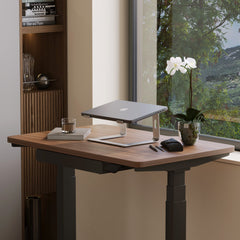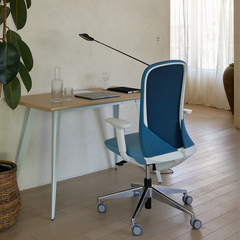Get 10% off your first order
Find the office furniture that’s designed to match your style, comfort, and needs perfectly. Subscribe
The Shape of Focus: How Furniture Design Influences Remote Work Habits

Visit quiz page to see how we makes it easy to create an inspiring workplace

Creative work is an interplay of focus, inspiration, and physical endurance. Designers, illustrators, editors, and writers spend long hours translating ideas into tangible form, often without realizing how their chair impacts both comfort and creativity. A poorly designed seat can gradually undermine focus, while a supportive, well-engineered one sustains energy and protects long-term health.
Research from public health institutions confirms that ergonomic seating reduces musculoskeletal stress and improves cognitive endurance. The NIOSH guidance on workstation ergonomics outlines how proper posture and seating support help prevent strain-related fatigue — an essential consideration for anyone whose creativity relies on consistent, comfortable concentration.

A chair should allow natural movement without losing support. Neutral alignment keeps the spine’s S-curve intact while enabling micro-movements that stimulate circulation. Creative work often involves alternating between focused and relaxed postures; the right chair adapts seamlessly to both.
The lower spine requires flexible contact, not rigid padding.
Dynamic lumbar systems adjust naturally as posture changes.
Proper lumbar alignment reduces pressure points and supports long hours of creation.
A smooth, synchronized recline keeps visual orientation stable during design review.
Adjustable tension ensures support while shifting between sketching and reflection.
Reclining briefly helps refresh circulation and creative clarity.
Correct seat height keeps forearms parallel to the desk and feet planted evenly. Seat depth that allows a small gap behind the knees prevents circulatory restriction. Weight should rest evenly across the thighs for comfort and sustained energy.
Adjustable height and width make transitions between pen, keyboard, or mouse effortless.
Rounded edges prevent compression during fine motor work.
Supportive armrests stabilize the shoulders and upper body during editing or drawing.
Mesh and performance fabrics enhance airflow, keeping users comfortable in long, high-focus sessions. Stable frame construction ensures quiet operation and prevents distraction — essential in studios and collaborative environments.
Graphic designers and architects frequently alternate between forward-leaning detail work and relaxed evaluation. The Novo chair with adaptive lumbar architecture offers responsive support that adjusts automatically to posture shifts, maintaining balance between alignment and creative flow.
In studios that double as presentation spaces, appearance and comfort carry equal weight. The Muse chair for visually expressive studios delivers an artistic profile that blends seamlessly into curated spaces. Its form supports posture while complementing the aesthetic vision of creative environments.
Writers, editors, and digital artists often sit for extended periods where subtle back strain can break concentration. The Onyx chair engineered for extended focus provides firm structural integrity, even weight distribution, and controlled flexibility to maintain spinal alignment without rigidity.
Minimalist studios thrive on clarity and quiet. The Seashell chair with minimalist contours combines sculpted simplicity with ergonomic reliability, allowing creators to maintain focus without aesthetic distraction.
| Creative Role | Primary Postures | Chair Priorities | Why It Matters |
|---|---|---|---|
| Graphic Designer | Forward-leaning precision | Adaptive lumbar, tilt flexibility | Maintains balance during iterative adjustments |
| Video Editor | Long seated durations | Firm back, pressure balance | Prevents fatigue in stationary work |
| Illustrator | Hovering over tablet | Adjustable armrests, seat depth | Reduces shoulder strain during stylus use |
| 3D Artist | Alternating focus modes | Smooth tilt, breathable material | Supports long creative modeling sessions |
| Writer | Upright, intermittent recline | Consistent lumbar, gentle recline | Sustains comfort through extended writing |
| Creative Director | Varied posture, meetings | Aesthetic appeal, mobility | Blends form, comfort, and leadership presence |
Track how you move through a typical day. If you spend hours drawing or typing, prioritize adjustability. If you shift frequently between standing, reviewing, and discussing, look for mobility and stability.
Designers: Prioritize back flexibility and armrest precision.
Writers: Seek consistent lumbar engagement.
Editors: Choose a smooth recline and balanced cushioning.
Directors: Focus on visual presence paired with ergonomic function.
1. Sit upright and adjust seat height until thighs are parallel.
2. Confirm lumbar contact matches the curve of your back.
3. Rest arms naturally and ensure shoulders remain relaxed.
4. Test recline tension for smooth return and stability.
Your workspace functions best when all ergonomic components align. Desk height, monitor position, and chair configuration determine how sustainable your posture feels throughout creative cycles. A well-matched setup helps avoid shoulder fatigue and wrist compression. Consider complementing your chair with options from the ergonomic desks that pair with pro chairs collection for balanced workspace design.
A hybrid of breathable mesh and responsive foam cushions provides the best balance of airflow and support. Mesh backs allow movement while foam seats distribute pressure evenly across the hips.
Quiet movement mechanisms sustain flow during recording or editing.
Reinforced frames prevent posture drift and maintain long-term integrity.
Smooth, predictable recline motion reduces micro-distractions.
The chair is both tool and inspiration. Rounded contours evoke calm; geometric silhouettes promote focus and structure. Selecting materials and tones that mirror your creative energy can subtly shape daily productivity.
Soft-touch materials encourage comfort and reduce tension. Subtle tactile textures ground the user’s awareness, blending physical ease with emotional calm — an understated yet powerful influence on creative performance.

Opt for smaller frames and breathable upholstery.
Use chairs with mobility and height range versatility.
Choose chairs with consistent lumbar contact and smooth rolling bases.
Match design language to studio aesthetics for professional coherence.
Prioritize fast, intuitive adjustment controls.
Use neutral colors that blend across varied workspace styles.
1. Work in normal posture for five minutes to evaluate lumbar consistency.
2. Lean forward as if sketching; confirm back support follows smoothly.
3. Recline gently; the transition should feel balanced, not abrupt.
4. Shift side to side; stability should remain even.
5. Sit and stand twice; test for wobble or friction.
Pressure under knees or thighs.
Armrests that misalign with desk height.
Recline that disengages lumbar contact.
Seat pan that tilts pelvis uncomfortably forward or backward.
Vacuum mesh and fabric regularly to remove dust.
Check all screws and levers quarterly for smoothness.
Recalibrate lumbar and tilt settings after moving your desk or monitor height.
Avoid leaning on armrests while standing to preserve mechanism integrity.
Creative professionals increasingly value sustainability as an extension of their practice. Chairs designed with recyclable materials and modular construction minimize waste while maintaining longevity. Modular parts that can be replaced extend the lifespan of quality designs. For those creating cohesive setups, explore customizable workspace bundles for creatives to curate ergonomic combinations that balance design, comfort, and responsibility.
Browsing a design-forward office chair collection provides insight into modern ergonomic innovation. Compare designs by function — from sculptural studio pieces to streamlined minimalist models — to identify which configuration aligns with your craft and personality.
Adjust seat height for neutral wrist angles.
Keep armrests slightly behind to avoid tablet interference.
Set moderate tilt tension for micro-movement without losing alignment.
Firm yet breathable cushioning reduces discomfort during long renders.
Smooth rolling casters prevent audio contamination in sound-focused studios.
Adjust lumbar placement to gently meet the curve of the lower spine.
Maintain small knee clearance for circulation during extended typing.
| Activity Level | Frequent Task | Key Feature to Prioritize | Reason |
|---|---|---|---|
| High | Precision sketching | Forward-leaning lumbar support | Preserves posture when leaning in |
| High | Long-form writing | Balanced cushioning | Prevents fatigue over extended sessions |
| Medium | Client presentations | Synchronized recline | Enables relaxed viewing posture |
| Medium | Collaborative sessions | Armrest mobility | Allows seamless lateral movement |
| Low | Light administration | Static backrest | Simplifies setup for short intervals |
Work is increasingly fluid, spanning offices, homes, and shared spaces. Chairs designed for hybrid workflows emphasize portability, lightweight materials, and easy customization. These traits allow creative professionals to maintain comfort wherever they create.
Workspace aesthetics differ globally. Urban environments tend toward minimalist, monochrome seating, while creative hubs in warmer climates lean toward natural materials and organic shapes. Understanding these preferences ensures that workspace design resonates with both culture and climate.
Furniture makers are adopting recyclable frames, modular cushions, and low-emission finishes. These choices reflect an industry-wide commitment to responsible production and long-term usability. Creative professionals benefit from designs that respect both body and planet.
Manufacturers refine each new generation of chairs using real-world usage data. Subtle evolutions — like improved tilt balance or adaptive lumbar geometry — emerge from observing how creatives actually move throughout the day.
Ergonomic innovation is shaped by cross-cultural design exchange. Scandinavian minimalism, Japanese simplicity, and North American engineering each contribute distinct perspectives that together define the modern creative chair — merging functionality, durability, and artistry.
As the boundaries between workspace and lifestyle continue to blur, office chairs for creative professionals will remain central to productivity and wellbeing. Future designs will likely emphasize balance merging sustainability with scientific ergonomics and timeless aesthetics.
When form, function, and comfort align, creativity thrives effortlessly. The ideal chair becomes not just a seat, but a quiet collaborator supporting the rhythm, focus, and imagination that bring every idea to life.

The Shape of Focus: How Furniture Design Influences Remote Work Habits

Work That Flows: Designing a Home Office That Actually Works

Choosing a Chair for Hardwood or Tile Floors
Get 10% off your first order
Find the office furniture that’s designed to match your style, comfort, and needs perfectly. Subscribe
Leave a comment